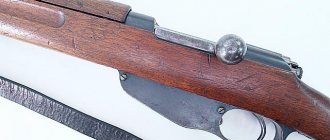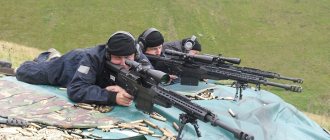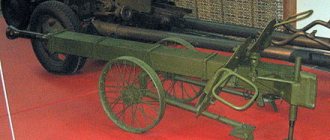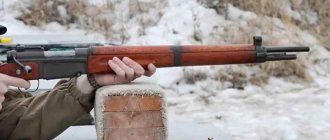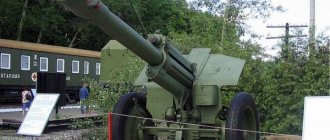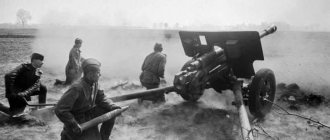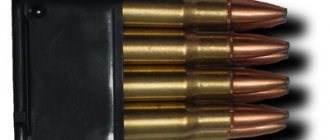Berdanka was made by the excellent inventor Hiram Berdan in 1868, and it was finalized by Russian Colonel A.P. Gorlov and Lieutenant K.I. Gunius. The Berdana began to be used in 1868 as a “shooting rifle.” Knowing its amazing ballistics, the first were armed with those isolated from the front line, operating in loose formation and avoiding close combat.
In 1870, the standards that had become a thing of the past were replaced by the Berdana 2. This rifle had a sliding bolt, later it was replaced by the Albini-Baranova, which was a weapon of the Russian fleet.
These rifles were used in the guards units of the Russian army during the war with the Turks in 1877-1978 and were then used even when the Nagant and Mosin appeared. During the First World War, some fighters used Berdanka 2 caliber 10.75x58r.
custom_block(1, 81103712, 1089);
In 1877, the army had Berdanka 2 in the amount of 2,253,152 units. in service and 103,616 in reserve and Berdanka 1 in the amount of 1,17,810 units. in service and 10,104 in reserve.
And in 1900, a small number of Berdanok 2s, in some places up to 250,000, were converted into a more effective caliber 7.62x54R. The gun received a new bolt with a spring in front and a longer bolt handle. The barrel was also changed, the new one was longer.
The Berdanka 2 was also adopted by Bulgaria and also had very limited deployment by Finland.
Berdyanka mechanism
custom_block(5, 98565315, 1089);
The Berdanka rifle was bolt-action and weighed 10 pounds with bayonet. The length of the rifle with the absence of a bayonet is 53 inches, with its presence 73 inches. For the guards units she had a cleaver. With the cleaver it is 73.5 inches long and weighs about 12 pounds. The 10.75x58r cartridge used in Berdanka was also invented by Hiram Berdan, with the help of Russian Colonel Gorlov. This cartridge was already more effective in use. The metal barrel has a screw rifling of rectangular cross-section, which runs from left to right. The bullet picks up speed at 1,400 feet per second and penetrates 9 7-inch pine boards at a distance of 200 paces. As the distance increases, the penetrating power of the bullet also changes.
custom_block(1, 85026274, 1089);
4.2-line chuck
The 4.2-line cartridge for the Berdan rifle (1868-1891), typical in design for its time, consisted of:
- a bottle-shaped brass sleeve with an annular protrusion at the base - a rim, a depressed bottom and an anvil protruding from it, against which the percussion composition of the primer is broken and from the base of which three holes lead into the sleeve to communicate fire to the charge;
- an internal brass cup, pressed inside the sleeve to strengthen the bottom, weakened by the kinks of the metal to form a flange;
- capsule - cups with a cake of percussion composition, covered with a thin tin circle;
- gunpowder charge;
- sealer - cups made of linen paper filled with stearin or squeezed out beef lard, intended for lubrication when the channel is fired, which makes it easier for carbon deposits to come off and lead avoiding
- smooth lead bullet, wrapped in paper (white for infantry cartridges, pink for cavalry cartridges), 1 bullet wrapper and inserted into a crimped barrel.
Operation and combat use
- Russian Empire - stored in a warehouse after 1891, used during the 1914 war.
- Bulgaria - in the 1914 war had 54,912 Berdanki 2 rifles.
- Kingdom of Montenegro - about 30 thousand Berdanka 3 rifles were supplied from the Russian Empire.
- Ethiopia - during the war of 95-96, it had 30 thousand rifles.
Comparative characteristics
Ballistic qualities of rifles from the period after the Franco-Prussian War chambered for standard cartridges according to the results of tests carried out[28][29]
| US Army Weapons Committee | British Army Armament Committee | |||||||||||||||
| Rifle | Mean absolute deviation ( mm ) | Bullet speed ( m /sec) | Trajectory height ( m ) | Weight ( g ) | ||||||||||||
| 457 m | 731.5 m | 960 m | 0 | 460 | 910 | 1400 | 1800 | 460 | 910 | 1400 | 1800 | gunpowder | bullets | |||
| single-shot | Peabody | USA | 424 | dropped out of the trials | no data | |||||||||||
| single-shot | Greena | USA | 503 | no data | ||||||||||||
| single-shot | Martini-Henry | British Empire | 261 | 510 | 856 | 401 | 265 | 202 | 155 | 119 | 2,9 | 14,6 | 44,8 | 109 | 5,5 | 31 |
| single-shot | Berdana | Russian empire | 325 | 678 | 1859 | 440 | 266 | 197 | 145 | 108 | 2,4 | 14,3 | 46,2 | 118,5 | 5 | 24 |
| single-shot | Beaumont | 416 | dropped out of the trials | no data | 4,5 | 22 | ||||||||||
| store | Vetterli | Switzerland | 574 | 440 | 255 | 181 | 129 | 93 | 2,6 | 15,9 | 53,7 | 143,2 | 4 | 20 | ||
| single-shot | Werndl | Austro-Hungarian Empire | "wild" | 439 | 260 | 190 | 137 | 100 | 2,5 | 15 | 49,6 | 129,8 | 5 | 24 | ||
After Berdanka was removed from service
Before the new large-scale rearmament, the Berdanka 2 fighter remained the last rifle until the 90s.
And later, when rearmament came out, Berdanka could not remain history. Old rifles were converted in large quantities into guns for hunters and they still serve today!
In many military schools of the Imperial Russian Federation there was a tiny number of Berdanoks. Rifles and bullets from them were in large quantities in warehouses. Disposal of obsolete weapons was not cheap, so they were converted into weapons for people, and not disposed of as they should be by melting down. But even though the rifles were expensive, they exceeded the potential capacity of the domestic gun market. In 1914, as before, there were a lot of rifles in specially designated premises. Since there was a panicky shortage of guns at the front, Berdanka was used at the front line as before. During the defense of the Novogeorgievsk fortress, more than half of the fighters were unarmed and only a small part could defend themselves with Berdanka - three hundred bullets per rifle.
On the front line with a gun it was even worse. The gun was ready for battle, any gun that could fire, including the outdated single-shot Berdanka. Because at first the Entente offered to help Russia with the Gra-Kropachek and Vetterli-Vitaly rifles that were outdated and removed from the front. With the smallest amount of ammunition for weapons, it was impossible to say that they would be sent to the front, although they were better in terms of rate of fire than the Berdanki due to the unique magazine feed.
Video about the rifle
On the battle front, black powder rifles did not last long: the smoke when firing and the low speed when firing did not allow the soldiers who were armed with this useless weapon to hold back the enemy’s pressure. The Germans massively propagated condemnation of the introduction of bullets without a jacket, saying that the wounds are more severe than those inflicted by modern rifles, talking about the parallel with “dum-dum” bullets, which is categorically not true. In any case, old black powder rifles were used temporarily and forcibly, but quickly and forever left the battlefield.
Story
Berdan rifle No. 1 caliber 4.5 line (11.43 mm) was developed by the American military man, hero of the American Civil War, Colonel Hiram Berdan. It had a hinged bolt with a direct trigger. Its use revealed some shortcomings: the shutter reacted sharply to dampness, the firing pin did not always fire, and if handled inattentively, the shutter could not close tightly. Two Russian officers sent to America in the early 1860s, Alexander Pavlovich Gorlov and Karl Ivanovich Gunius, made 25 different improvements to the design (not much remained of the original sample) and redesigned it to a 4.2 line caliber; They developed a cartridge for it with a solid-drawn sleeve - in the United States it was called nothing more than “Russian musket”. The production of rifles in the USA was carried out at a plant in Hartford, Connecticut (that is why in America it is known as the “Colt Berdan”, Colt Berdan rifle
). The rifle was adopted by the Russian army in 1868 as a “small rifle of the 1868 model” - without mentioning its original creator and subsequent innovators (subsequently, the documentation almost always used the expression “Berdan rifle”, in common parlance simply “Berdanka”). Taking into account its rather high, at the end of the 1860s - beginning of the 1870s, ballistic qualities, it was primarily armed with rifle units (light infantry, organizationally separate from the line infantry, which mainly operated in loose formation with firearms and avoided close combat) . By the beginning of the Russian-Turkish war of 1877-1878. About 37 thousand copies were released[1].
In 1870, instead of the Krnka rifle and other models remaining in service, the Russian army adopted a second model - “Berdan Rapid-Fire Small-Caliber Rifle No. 2”, in which H. Berdan, who arrived in St. Petersburg, replaced the folding bolt with a more advanced longitudinally sliding one [2][3]. Russian inventors made another dozen and a half significant changes to it and developed modifications - a dragoon rifle (Colonel V. L. Chebyshev) and a Cossack rifle and a cavalry carbine (Colonel Safonov)[1].
Berdan rifles No. 2 began to arrive in the army in 1871, and as their production expanded at domestic factories, rifles of older systems were gradually replaced. As of January 1, 1877, the army had[4]:
- Berdan rifles No. 2 of 1870 (infantry, dragoon, Cossack and carbines) - 253,152 in service and 103,616 in reserve;
- Berdan rifles No. 1 of 1868 (infantry and dragoons) - 17,810 in service and 10,104 in reserve;
- Krnka rifles of 1868 (infantry and dragoons) - 413,297 in service and 192,866 in reserve;
- Albini-Baranov rifles of 1868 (infantry) - 3691 in service and 6309 in reserve;
- Karle rifles 1867 (infantry) - 150,868 in service and 51,096 in reserve;
- Terry-Norman rifles 1866 (infantry) - 4126 in service and 7874 in reserve;
By 1877, they managed to rearm the Guards and Grenadier Corps, as well as all dragoon regiments. But most units still actually had old rifles; Template:no AI 2. The command did not dare to send people on a campaign with weapons unfamiliar to them, so in the battles of the initial period of the war, Russian units had the rifles that they had at the time it began and with which they practiced for at least a year, namely : Krnka systems on the Balkan front, Krnka and needle Karle systems on the Caucasus, Berdan No. 1 in rifle units and Berdan No. 2 in the guard. By January 1878, Berdan rifles No. 2 were in full service with 21 divisions, of which, however, not all were sent to the war zone. Subsequently, it replaced the Baranov rifle, which was in service with the Russian fleet. The soldiers carried all 60 cartridges for the rifle in cartridge bags[5].
In 1882, the Main Artillery Directorate set the task of developing a multi-shot repeating rifle, which was developed by the end of the decade and put into service in 1891. Nevertheless, the Berdanka was in service until the complete rearmament of the Russian army with the Mosin repeating rifle at the beginning of the 20th century.
In 1898-1899, rifles and carbines of Berdan No. 2, which were withdrawn from service, were sold as hunting weapons at a price of 18 rubles[6]
In 1910, in the Main Directorate of the General Staff, a special commission “on the distribution of artillery reserves”, having discussed the issue of the available 810,000 serviceable Berdan guns with 275 million completely reliable cartridges, came to the conclusion that if the designated militia units were supplied with Berdan guns, the remainder would be about 400,000 berdanks, which are uselessly cluttering already overburdened warehouses. Therefore, the commission proposed: Berdankas that were in excess against the norms should be removed from warehouses, using them by turning them into hunting rifles, for arming the Russian population on the outskirts and Russian rifle societies, and, finally, turning them into scrap metal[7].
By the beginning of the First World War, for 4,900,000 army soldiers in the army and in reserve, there were 4,652,419 three-line rifles and carbines (including reserves for replenishment of losses), as well as 363,019 Berdan rifles and carbines[8]. Berdan No. 2 cavalry carbines were the standard weapon for a number of mounted regiments, but a shortage of rifles during the First World War forced the use of stocks of Berdan rifles. At first, “Berdanks” were used to arm state militia squads, then to rear and reserve units, and from 1915 they began to arm combat units of the active army[9]. In January 1916, they began to be transferred from the active army to the rear units[10].
Who is Kozlevich to share with him?
At first, the cooperation of the two visiting officers with Hiram Berdan developed in the best possible way.
Hiram Berdan
Russian officers (or Berdan from their kicks) made a number of improvements to the rifle. They decided to arrange production at the Colt plant, which was run by another good man - General Franklin.
General Franklin
Since Berdan’s rifle, as it turned out, accidentally contained a few parts that were not entirely his own, the Koltovites nobly proposed the following option: Berdan cedes the rights to the rifle to them, they settle patent problems, and then sell the rifles to everyone - well, I mean, to the Russians.
The only obstacle in this noble cause was the Russian envoy to the United States, Stekl. The same one who recently ruled the sale of Alaska. He circled around and around, and constantly gave all sorts of hints to the Koltovites: there’s no need to negotiate with these two, I’d rather make you an order for 30 thousand rifles. General Franklin even wrote in his diary with indignation - wow, what a bad man! I tried to get into the work of good people for the benefit of Russia...
The third one is not superfluous!
The choice of the first two samples does not raise any special questions. The Remington system, known as the Remington Rolling Block, is considered one of the best. And for some - the best rifle of that period. It did not officially enter service with the American army (they couldn’t agree on the price; it was only purchased by the National Guard of the wealthy state of New York). Congestion with a bang!” went to Latin America and old Europe. For example, in Belgium, the Nagant company took up the production of rolling guns, and even the Pope’s guard was among its customers.
However, the Peabody system doesn't have to complain either. In a modified version (with a Swiss Martini percussion mechanism and Henry barrel rifling), it became the main infantry weapon of the British Empire. The same one on which the sun never set in the 19th century. And in other countries it was also actively bought, produced, and improved.
Here is what the St. George Cavalier of the Tsarist Army - and at the same time the engineer-colonel of the Soviet Army - Vladimir Markevich writes about them:
The bolt of the Remington rifle is durable, survivable, and small in size. No wonder it was in service in many countries. The Remington system was very popular among hunters; it functions well at low temperatures. Martini-type systems are widespread and widely used. They are rapid-fire, well sealed from dust and dirt penetrating the mechanism, making the weapon more portable and compact.”
But about the Berdan system - the one that Gorlov and Gunnius considered the best - Markevich does not write anything.
A plate from an experimental rifle, which later became Berdanka No. 1
It’s not surprising, because even Russia eventually abandoned it. And the same Americans, who, when choosing their new rifle, tested not even a few dozen, but 99 options (among them was the Berdan-Russian), eventually settled on the Springfield version in 1873.
How the rifle works
Let us pay attention to the principle of operation of the sliding shutter, revolutionary for those years (1870). It serves to open and close the barrel and moves in a box located on the axis of the barrel
The handle is connected to the extractor and the hammer. The movement of the handle from left to right locks the barrel, sends the cartridge into the chamber and at the same time serves to cock the firing pin, while the reverse movement leads to the ejection of the cartridge or spent cartridge case.
This design is not ideal and has been subject to justifiable criticism. Thus, the small stroke of the handle - only 45 degrees - could cause accidental opening of the bolt, which led to injuries among careless and inattentive shooters, this happened especially often in worn-out samples.
Serious disadvantages include cocking the hammer, which is illogically connected with the movement of the bolt handle: not with the initial blow on it, but directly related to the movement back and forth. This decision was the reason for installing a weak mainspring, and because of it, misfires occurred in severe frosts, when the force of the firing pin was simply not enough to pierce the cartridge primer.
Despite the listed disadvantages, the Berdanka was superior in accuracy to almost all other analogs existing at that time, only slightly inferior to the British Martin-Henry design, and the production price, ease of learning and practical rate of fire were decisive arguments when discussing the feasibility of adopting it for service.
Design Features
The following main elements can be distinguished (a sample from 1868 is indicated):
The barrel and the front sight soldered to it with the whole; The receiver is cylindrical in shape with a bolt placed in it and a reflector screwed in from below; The lock box, which contains the trigger and mainspring; An arrow connected to the bolt and ejector; The locking mechanism is a combination of a trigger and a combat mechanism, with safety cocks; The trigger mechanism includes a trigger spring, a sear and a trigger; Lodge; Bayonet.
In further development, individual elements were modified, sometimes significantly, for example, the bolt, but the overall configuration remained the same. With the transfer of production to Russia, the stock made of American walnut (now specimens with them are real rarities) was replaced by birch, and the bayonet model was replaced (depending on the type of troops, triangular bayonets or cutlasses were used).
The flap bolt had some advantage over existing models
